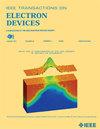不同存储器的单片三维集成:电阻开关(RRAM)和增益单元(GC)存储器集成在硅CMOS上
IF 2.9
2区 工程技术
Q2 ENGINEERING, ELECTRICAL & ELECTRONIC
引用次数: 0
摘要
未来的内存是巨大的、多样的,并且与计算紧密集成。本研究提出了两种片上存储技术,电阻开关随机存取存储器(RRAM)和增益单元存储器(GC)在物理和架构上的紧密集成。HfO2 RRAM和氧化铟锡(ITO) GC存储器在130纳米Si CMOS技术上单片集成,形成联合存储器,为边缘器件提供低能量训练和低备用功率推断。高带宽片上数据传输的带宽可以达到90美元的最先进(SoTA) HBM3E和211美元的PCIe 7.0,通过集成联合内存宏中存储阵列和高速传输电路之间的高密度单片3d互连实现。制备的原子层沉积(ALD) ITO FET具有0.67 V的正${V}_{\text {TH}}$,良好的亚阈值斜率(SS)为65 mV/dec,高导通电流为$20~\mu $ A/ $\mu $ m,低关断电流为$5\ × 10^{-{18}}$ A/ $\mu $ m,从>5000 s保留中提取。与同等容量的SRAM相比,联合内存宏对MobileBERT的待机功耗降低了78%,训练功耗降低了95%。这种RRAM-GC联合存储器促进了边缘设备中高效的持续学习,解决了资源受限环境的挑战,同时支持自适应人工智能(AI)模型更新。本文章由计算机程序翻译,如有差异,请以英文原文为准。
Monolithic 3-D Integration of Diverse Memories: Resistive Switching (RRAM) and Gain Cell (GC) Memory Integrated on Si CMOS
The future memory is massive, diverse, and tightly integrated with computing. This research presents tight integration, both physically and architecturally, of two on-chip memory technologies, resistive switching random access memory (RRAM) and gain cell (GC) memory. HfO2 RRAM and indium tin oxide (ITO) GC memory are monolithically integrated on 130-nm Si CMOS technology to form a joint memory that enables low-energy training and low-standby-power inference for edge devices. High-bandwidth on-chip data transfer can have a bandwidth that is $90\times $ state-of-the-art (SoTA) HBM3E and $211\times $ PCIe 7.0, enabled by high-density monolithic 3-D interconnections between memory arrays and high-speed transfer circuit within the integrated joint memory macro. Fabricated atomic layer deposition (ALD) ITO FET exhibits positive ${V}_{\text {TH}}$ of 0.67 V, excellent subthreshold slope (SS) of 65 mV/dec, high on-current of $20~\mu $ A/ $\mu $ m, and low off-current of $5\times 10^{-{18}}$ A/ $\mu $ m, as extracted from >5000 s retention. The joint memory macro consumes 78% less standby power and 95% less training energy for MobileBERT compared to SRAM with iso-capacity. This RRAM-GC joint memory facilitates efficient continual learning in edge devices, addressing the challenges of a resource-constrained environment while supporting adaptive artificial intelligence (AI) model updates.
求助全文
通过发布文献求助,成功后即可免费获取论文全文。
去求助
来源期刊

IEEE Transactions on Electron Devices
工程技术-工程:电子与电气
CiteScore
5.80
自引率
16.10%
发文量
937
审稿时长
3.8 months
期刊介绍:
IEEE Transactions on Electron Devices publishes original and significant contributions relating to the theory, modeling, design, performance and reliability of electron and ion integrated circuit devices and interconnects, involving insulators, metals, organic materials, micro-plasmas, semiconductors, quantum-effect structures, vacuum devices, and emerging materials with applications in bioelectronics, biomedical electronics, computation, communications, displays, microelectromechanics, imaging, micro-actuators, nanoelectronics, optoelectronics, photovoltaics, power ICs and micro-sensors. Tutorial and review papers on these subjects are also published and occasional special issues appear to present a collection of papers which treat particular areas in more depth and breadth.
 求助内容:
求助内容: 应助结果提醒方式:
应助结果提醒方式:


